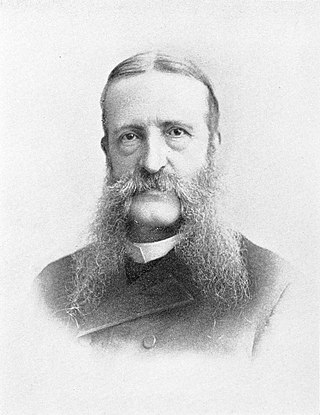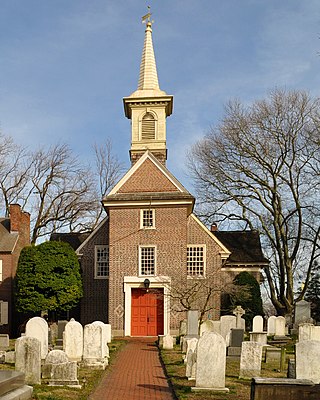
The Boston Public Library is a municipal public library system in Boston, Massachusetts, founded in 1848. The Boston Public Library is also Massachusetts' Library for the Commonwealth, meaning all adult residents of the state are entitled to borrowing and research privileges, and the library receives state funding. The Boston Public Library contains approximately 24 million items, making it the third-largest public library in the United States behind the federal Library of Congress and New York Public Library, which is also privately endowed. In 2014, the library held more than 10,000 programs, all free to the public, and lent 3.7 million materials.

Frank Heyling Furness was an American architect of the Victorian era. He designed more than 600 buildings, most in the Philadelphia area, and is remembered for his diverse, muscular, often inordinately scaled buildings, and for his influence on the Chicago-based architect Louis Sullivan. Furness also received a Medal of Honor for bravery during the Civil War.

Horace Howard Furness was an American Shakespearean scholar of the 19th century.

The Pennsylvania Academy of the Fine Arts (PAFA) is a museum and private art school in Philadelphia, Pennsylvania. It was founded in 1805 and is the first and oldest art museum and art school in the United States.

William Frederick Poole was an American bibliographer and librarian.

Broad Street Station at Broad & Market streets was the primary passenger terminal for the Pennsylvania Railroad (PRR) in Philadelphia from early December 1881 to the 1950s. Located directly west of Philadelphia City Hall, the site is now occupied by the northwest section of Dilworth Park and the office towers of Penn Center.

The architecture of Philadelphia is a mix of historic and modern styles that reflect the city's history. The first European settlements appeared within the present day borders of Philadelphia, Pennsylvania in the 17th century with most structures being built from logs. By the 18th century, brick structures had become common. Georgian and later Federal style buildings dominated much of the cityscape. In the first half of the 19th century, Greek revival appeared and flourished with architects such as William Strickland, John Haviland, and Thomas U. Walter. In the second half of the 19th century, Victorian architecture became popular with the city's most notable Victorian architect being Frank Furness.

Philadelphia's Baltimore & Ohio Railroad station – also known as the B & O station or Chestnut Street station – was the main passenger station for the Baltimore & Ohio Railroad in Philadelphia, Pennsylvania. Designed by architect Frank Furness in 1886, it stood at 24th Street and the Chestnut Street Bridge from 1888 to 1963.

The Centennial National Bank is a historic building in Philadelphia, Pennsylvania. Designed by noted Philadelphia architect Frank Furness and significant in his artistic development, it was built in 1876 as the headquarters of the eponymous bank that would be the fiscal agent of the Centennial Exposition. The building housed a branch of the First Pennsylvania Bank from 1956 until Drexel University purchased it c. 1976. Drexel renovated it between 2000-2002 and now uses it as an alumni center. The Centennial National Bank, described as "one of the best pieces of architecture in West Philadelphia," was placed on the National Register of Historic Places in 1971.

Daniel Pabst was a German-born American cabinetmaker of the Victorian Era. He is credited with some of the most extraordinary custom interiors and hand-crafted furniture in the United States. Sometimes working in collaboration with architect Frank Furness (1839–1912), he made pieces in the Renaissance Revival, Neo-Grec, Modern Gothic, and Colonial Revival styles. Examples of his work are in the collections of the Metropolitan Museum of Art, the Philadelphia Museum of Art, the Art Institute of Chicago, and the Victoria and Albert Museum in London.

John McArthur Jr. (1823–1890) was a prominent American architect based in Philadelphia. Best remembered as the architect of the landmark Philadelphia City Hall, McArthur also designed some of the city's most ambitious buildings of the Civil War era. Few of his buildings survive.

Wilson Brothers & Company was a prominent Victorian-era architecture and engineering firm based in Philadelphia, Pennsylvania. The company was regarded for its structural expertise.

The Provident Life & Trust Company is a demolished Victorian-era building in Philadelphia designed by architect Frank Furness and considered to be one of the famed architect's greatest works. A bank and insurance company founded in 1865 by members of the Society of Friends (Quakers), the Provident's L-shaped building had entrances at 407–09 Chestnut Street, which served as the entrance to the bank, and at 42 South 4th Street, which was the entrance to the insurance company. The two wings were eventually consolidated into an office building, also designed by Furness, at the northwest corner of 4th and Chestnut Streets.

William L. Johnston (1811–1849) was a carpenter-architect who taught architectural drawing at the Carpenters' Company of Philadelphia, and won a number of important Philadelphia commissions. He died of tuberculosis at the age of 38 after a trip abroad for his health.
The Mercantile Library Association (1820-1952) of Boston was an organization dedicated to operating a subscription library, reading room and lecture series. Members included James T. Fields and Edwin Percy Whipple. Although the association had a relatively long history, its heyday occurred in the mid-19th century, particularly the 1840s and 1850s.

Matthew Newkirk was an American businessman, railroad magnate, banker and philanthropist. He was president of the Philadelphia, Wilmington and Baltimore Railroad (PW&B) and led the integration of four railroad companies to establish the first direct rail service between Philadelphia and Baltimore. He was a director of the Second Bank of the United States; and an investor in the Little Schuylkill Navigation, Railroad and Coal Company and the Cambria Iron Company.

The Center for Fiction, originally called the New York Mercantile Library, is a not-for-profit organization in New York City, with offices at 15 Lafayette Avenue in Fort Greene, Brooklyn. Prior to their move in early 2018, The Center for Fiction was located at 17 East 47th Street, between Madison and Fifth Avenues in Midtown Manhattan. The center works to promote fiction and literature and to give support to writers. It originated in 1820 as the Mercantile Library and in 2005 changed its name to the Mercantile Library Center for Fiction, although it presents itself as simply "The Center for Fiction".

Lindenshade(Wallingford, Pennsylvania), was the Wallingford country house and farm of Shakespearean scholar Horace Howard Furness (1833–1912) and family. The house's design is attributed to his brother, architect Frank Furness. It was expanded numerous times, and demolished in 1940. Two other buildings from the property survive. The Helen Kate Furness Library, a memorial to HHF's wife, was built at the west end of the property in 1916.

J.E. Caldwell & Co. was a major jewellery retailer and one-time silversmith in Philadelphia, Pennsylvania.

The Chestnut Street Opera House was a theatre located at 1021–1029 Chestnut Street in Philadelphia, Pennsylvania. Built by theatre impresario Robert Fox on the former site of the Pennsylvania Academy of the Fine Arts, it opened as a venue for vaudeville in 1870 as Fox's New American Theatre. The theatre was destroyed by fire in 1877 and was rebuilt that same year. After being acquired by George K. Goodwin, the theatre was remodeled, renamed the Chestnut Street Opera House, and re-opened as a legitimate theatre in 1880. It continued to operate as a legitimate theatre, first under the management of theatre magnates Samuel F. Nixon and J. Fred Zimmerman Sr., who acquired the theatre's lease in 1882, and later under the Shubert Organization, who acquired the theatre in 1916. It was still considered one of Philadelphia's leading legitimate theatres during the 1920s and 1930s. The theatre was also used as a venue for films and was a model theatre for the Triangle Film Corporation in 1915–1916. The theatre closed in 1939 and was demolished in 1940.





















